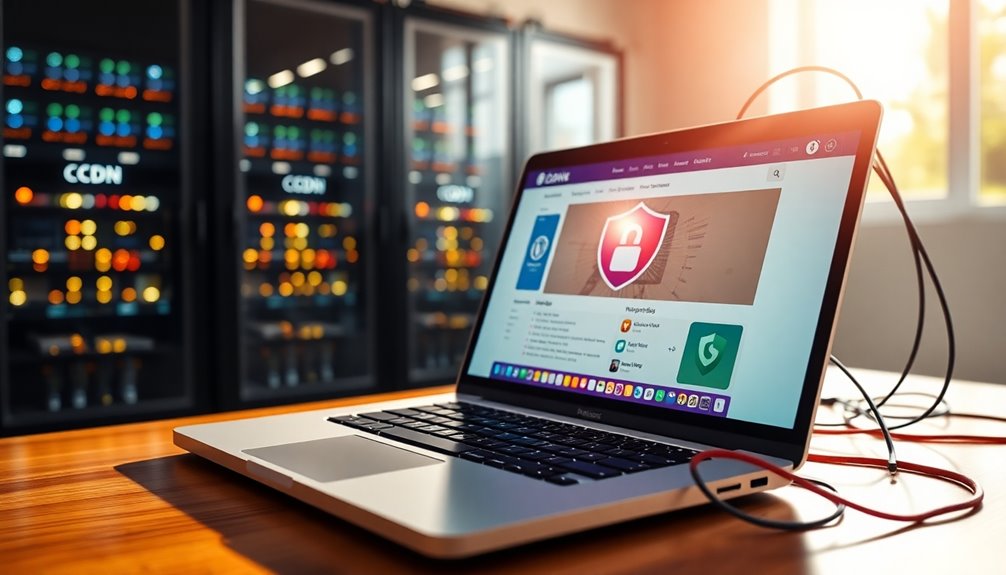Integrating a Content Delivery Network (CDN) with your WordPress site greatly boosts security and performance. CDNs reduce server load and act as a first line of defense against threats like DDoS attacks, while SSL encryption protects sensitive data. By caching content on servers closer to users, CDNs enhance load times and improve user experience. You'll want to choose a CDN provider that offers strong security features and compatibility with WordPress. Plus, keeping your CDN settings updated is essential for ongoing protection and performance. There's a lot more you can optimize for your site, which you'll discover shortly.
Understanding Content Delivery Networks
When it comes to improving your website's performance, understanding Content Delivery Networks (CDNs) is essential.
A CDN is a global network of servers that caches static content, like images and JavaScript, delivering it from the nearest server to reduce latency. This means your WordPress site's performance gets a significant boost, as users experience faster load times. Additionally, outdated themes and plugins can compromise the efficiency of your CDN. Implementing strong password policies can further enhance your security as you utilize CDN services.
By offloading static resources to a CDN, you lessen the load on your primary server, leading to improved response times.
Additionally, many CDNs come equipped with security features, including DDoS protection and SSL encryption, which help safeguard your site. Implementing a CDN can also help mitigate brute force attacks, as it enhances the overall security posture of your WordPress installation.
Benefits of CDN for Security
While you focus on enhancing your WordPress site's performance, don't overlook the security benefits that a CDN provides.
CDN security acts as your first line of defense, filtering out malicious traffic before it reaches your server, which notably reduces the risk of attacks. Utilizing security plugins is essential for asset protection and maintaining customer trust through proactive measures. Many top security plugins, such as MalCare Security Plugin, offer comprehensive protection features that complement CDN capabilities.
With DDoS protection, CDNs absorb and mitigate large-scale attacks, ensuring site availability during surges.
SSL certificates encrypt sensitive data at edge servers, protecting against eavesdropping.
Origin cloaking masks your server's IP address, making it harder for attackers to target you directly.
Plus, the integration of a Web Application Firewall (WAF) filters harmful requests and defends against common vulnerabilities like SQL injection and cross-site scripting (XSS), further enhancing WordPress security. Additionally, implementing strong passwords alongside CDN measures fortifies your site's defenses against unauthorized access.
Choosing the Right CDN Provider

Integrating a CDN into your WordPress site not only boosts performance but also raises significant considerations about selecting the right provider.
Look for a CDN provider that aligns with your security needs, offering robust features like DDoS protection and a Web Application Firewall (WAF). A strong focus on encrypted backups can further enhance your site's security posture. Additionally, backup plugins are essential for safeguarding your site against data loss and breaches.
Evaluate their global network size and Points of Presence (PoPs) to guarantee peak content delivery speed for your users.
Also, check for compatibility with your WordPress configuration; providers with specific plugins can simplify CDN integration.
Don't forget to compare pricing models, as they can vary widely.
Finally, review customer support options, as reliable assistance is vital for resolving issues swiftly and guaranteeing the performance and security of your site. Additionally, ensure that your chosen CDN provider is capable of mitigating plugin vulnerabilities to enhance overall WordPress security.
Setting Up Your CDN
Setting up your CDN is essential for enhancing your WordPress site's performance.
Start by choosing a CDN provider that fits your needs, then configure the plugin settings to optimize content delivery. Additionally, ensure that your CDN is integrated with regular security scans to monitor for potential threats and suspicious activity. Furthermore, utilizing a CDN can significantly improve website uptime by reducing load times and ensuring content is delivered efficiently. A well-configured CDN can also bolster security measures by distributing traffic and preventing overload on your server. Finally, don't forget to test your CDN's performance to guarantee it's working effectively.
Choose CDN Provider Wisely
Choosing the right CDN provider can greatly impact your WordPress site's performance and security. When you choose a CDN, consider performance factors like the number of Points of Presence (PoPs) available globally. A larger network can enhance site speed and reduce latency for users everywhere.
Don't overlook security features; look for DDoS protection, SSL/TLS support, and Web Application Firewalls (WAFs) to safeguard your site. Compare pricing models among CDN providers to find one that fits your traffic and budget.
Also, seek out providers that offer WordPress-specific plugins or integration tools to streamline the setup. Finally, assess their customer support—responsive assistance is vital during implementation and troubleshooting, ensuring you can effectively integrate your CDN.
Configure Plugin Settings
After selecting a suitable CDN provider, the next step involves configuring the plugin settings to optimize your WordPress site.
Start by installing and activating a compatible CDN plugin, like W3 Total Cache or Cloudflare, from your dashboard.
Once activated, navigate to the plugin settings and enter your CDN URL or CNAME, specifying which content types—such as images, CSS, and JavaScript—should be served through the CDN.
Adjust caching settings, including Time-To-Live (TTL) values, to control how long content is stored before refreshing from the origin server.
Don't forget to enable SSL/TLS support in the CDN settings to guarantee secure content delivery, enhancing both security and performance while improving page load times for your visitors.
Test CDN Performance
How can you guarantee your CDN is performing at its best? Start by testing CDN performance with tools like GTmetrix and Pingdom. Analyze load times and server response before and after CDN integration to see clear improvements.
Regularly monitor key metrics, such as cache hit ratio and bandwidth usage, to understand how effectively your CDN manages traffic. Conduct speed tests across various geographic locations to assess latency reduction for users near edge servers.
Leverage CDN analytics to uncover traffic patterns and user engagement statistics, essential for optimizing content delivery. Finally, evaluate the impact of CDN integration on your SEO performance by tracking changes in search engine rankings and user engagement metrics.
This ascertains your CDN is fully optimized for success.
Integrating CDN With WordPress

When you integrate a CDN with WordPress, you're taking a significant step toward enhancing your site's speed and performance.
Start by selecting a suitable CDN provider like Cloudflare or Amazon CloudFront. Once you've created an account, install a compatible plugin to connect your site with the CDN.
In the plugin settings, enter the CDN URL and specify which content types—such as images, CSS, and JavaScript—you want to serve through the CDN. Using a reliable security plugin can further protect your site from vulnerabilities while integrating with your CDN.
To optimize site performance, update WordPress configuration to direct static content to the CDN. Implementing a secure file upload plugin can further enhance data protection standards and ensure your uploaded files are safeguarded against vulnerabilities.
Regularly monitor your site's performance using tools like GTmetrix to guarantee effective caching and content delivery.
Don't forget to leverage features like SSL/TLS support for improved security and DDoS protection. Additionally, using a reliable hosting provider can further enhance your site's overall stability and performance.
CDN Security Features Overview
Integrating a CDN with your WordPress site not only boosts speed and performance but also enhances security.
CDN security features play a vital role in safeguarding your website. With DDoS protection, incoming traffic is distributed across multiple servers, reducing the impact of attacks and maintaining site availability.
Origin cloaking masks your server's IP address, preventing direct assaults on it. Many CDNs provide a Web Application Firewall (WAF) that filters and monitors HTTP traffic, defending against common vulnerabilities like SQL injection and XSS.
SSL/TLS encryption at edge servers secures sensitive data during transmission. Additionally, traffic filtering identifies and blocks suspicious requests before they reach your origin server, decreasing server load and improving site reliability.
CDN and DDoS Protection

When you think about DDoS attack mitigation, CDNs play an essential role in defending against these threats.
By utilizing edge server traffic filtering and enhanced security features, they can effectively manage and redirect harmful traffic before it reaches your site.
This proactive approach not only safeguards your WordPress site but also boosts its overall reliability.
DDoS Attack Mitigation Strategies
DDoS attacks can cripple your WordPress site, but implementing a Content Delivery Network (CDN) offers powerful strategies for mitigation.
Here are three key ways a CDN enhances your DDoS protection:
- Traffic Distribution: CDNs distribute incoming traffic across multiple Points of Presence (PoPs), reducing server load and absorbing malicious traffic.
- Advanced Security Features: With capabilities like rate limiting and IP blacklisting, a CDN helps block suspicious requests, enhancing your site's security during an attack.
- Reverse Proxy: By masking your origin server's IP address, a CDN makes it more challenging for attackers to target your server directly.
Edge Server Traffic Filtering
Edge server traffic filtering serves as an essential defense mechanism for your WordPress site, ensuring that only legitimate requests reach your origin server.
By utilizing edge servers, your CDN can effectively filter traffic, blocking malicious requests before they impact your site. This proactive approach greatly mitigates DDoS attacks, as the CDN disperses excessive traffic across multiple Points of Presence (PoPs), preventing overload on your origin server.
Additionally, many CDN providers incorporate a Web Application Firewall (WAF) that enhances security by filtering out harmful requests and addressing known vulnerabilities.
With effective traffic filtering, you'll enjoy reduced server load and improved performance, keeping your website operational and responsive even during potential attacks.
Enhanced Security Features
To enhance your WordPress site's security, integrating a Content Delivery Network (CDN) with robust DDoS protection is essential.
Here are three key features to take into account:
- Traffic Distribution: CDNs distribute incoming traffic across multiple Points of Presence (PoPs), effectively mitigating DDoS attacks and ensuring your site remains available.
- Web Application Firewall (WAF): A WAF monitors and filters HTTP traffic, blocking malicious requests before they reach your origin server.
- Origin Cloaking: This feature masks your server's IP address, making it harder for attackers to target your site directly.
Additionally, SSL/TLS encryption protects sensitive data in transit, enhancing overall security and maintaining user trust.
Ssl/Tls Encryption With CDN
When you integrate SSL/TLS encryption with a CDN, you're not just enhancing security; you're also optimizing your site's performance and boosting its credibility.
SSL/TLS guarantees that data transmitted between your users' browsers and the CDN is secure, protecting sensitive information from eavesdropping and man-in-the-middle attacks.
Many CDNs offer free SSL/TLS certificates, making it easy and cost-effective to secure your WordPress site.
This integration allows for faster, more efficient content delivery over secure connections, markedly improving user experience.
Additionally, having SSL/TLS in place can elevate your SEO rankings since search engines like Google prioritize secure websites.
Ultimately, this setup fosters user trust, as visitors feel more confident engaging with sites that indicate a secure connection.
Monitoring CDN Performance

To guarantee your CDN is performing at its best, you need to focus on tracking key performance metrics.
Keep an eye on load times and other analytics so you can spot any issues quickly.
Regular analysis allows you to make informed adjustments that enhance your site's speed and reliability.
Performance Metrics Tracking
Monitoring CDN performance is essential for guaranteeing your WordPress site runs efficiently and meets user expectations.
To effectively track performance metrics, focus on these key areas:
- Cache Hit Ratio: Measure the percentage of requests served from the CDN cache to evaluate efficiency.
- Server Response Times: Monitor these to identify latency issues and guarantee fast content delivery from the nearest edge server.
- User Engagement Metrics: Analyze bounce rates and average session durations before and after CDN integration to quantify improvements in user experience.
Utilize tools like Google Lighthouse and GTmetrix for performance metrics tracking, and leverage CDN analytics dashboards to gain insights into traffic patterns and site speed.
This way, you can enhance user engagement while optimizing your WordPress site's performance.
Analyzing Load Times
How can you guarantee your CDN is effectively boosting your site's load times? Start by monitoring key performance metrics like load times, cache hit ratios, and server response times.
Tools such as Google Lighthouse and GTmetrix help you analyze how CDN integration impacts page speed and reveal areas needing enhancement. Regularly track the loading time of static assets delivered via the CDN to identify any bottlenecks, ensuring consistent content delivery across various locations.
Furthermore, keep an eye on user experience metrics like bounce rates and session duration to understand the correlation between improved load times and visitor engagement.
Setting up performance alerts can also help you quickly address significant changes in load times, maintaining ideal CDN functionality and enhancing user experience.
Best Practices for CDN Security
While integrating a Content Delivery Network (CDN) can greatly enhance your WordPress site's performance, it's essential to prioritize security measures that protect your data and infrastructure.
Here are some best practices for CDN security:
- Implement a Web Application Firewall (WAF): It filters out malicious traffic and defends against common web threats, strengthening your site's security.
- Utilize DDoS protection: This distributes and mitigates overwhelming traffic, ensuring your site remains accessible during attacks.
- Enable SSL/TLS encryption: Secure data in transit to protect sensitive information from interception.
Additionally, regularly update your CDN's security settings and leverage origin cloaking to mask your server's IP address, reducing the risk of direct attacks and addressing new vulnerabilities effectively.
Future Trends in CDN Security

As cyber threats become increasingly sophisticated, staying ahead of the curve in CDN security is vital for website owners.
Future trends indicate a shift towards zero-trust architectures, requiring verification for every request to prevent unauthorized access.
Machine learning will play an important role in enhancing threat detection, adapting to emerging attack patterns in real time.
With improved edge computing, CDNs can analyze threats closer to users, accelerating response times.
AI tools will help accurately identify malicious traffic, reducing false positives.
As threats evolve, expect multi-layered security protocols to dominate, combining DDoS protection, SSL/TLS encryption, and Web Application Firewalls (WAFs) to create robust defense mechanisms.
Embracing these trends will guarantee your website remains secure in an ever-changing landscape.
Conclusion
In the world of WordPress security, remember that "an ounce of prevention is worth a pound of cure." By integrating a CDN, you not only enhance your site's speed but also bolster its defenses against threats. Choosing the right provider and implementing best practices can make all the difference. So, take the necessary steps today to secure your site and enjoy peace of mind, knowing you're protected against potential vulnerabilities. Don't wait—act now!



